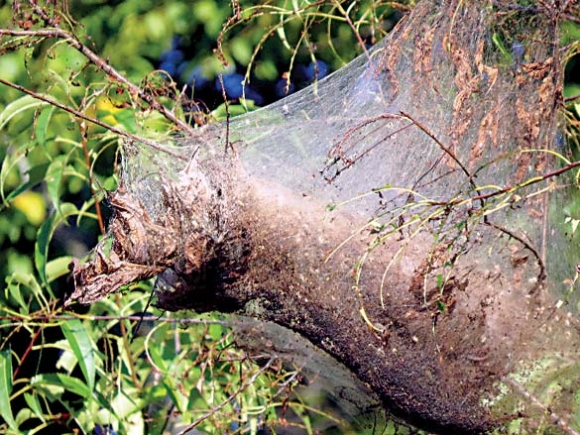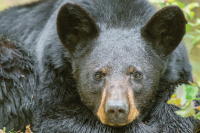Can’t see the forest for the webs

From what I gather from Facebook and overhear in the checkout line, the view I encounter every morning on my daily trip from Balsam Gap to Tuscola High School is pretty much standard across Western North Carolina and, according to a Google search across much of the country – places like Michigan, Pennsylvania, Maryland, Missouri, and others. That view is one of roadside trees full of what looks like dirty gray-brown plastic bags.
Those bags are home to the fall webworm, Hyphantria cunea, and it seems to be a banner year. The fall webworm is the caterpillar stage of the — wait for it — fall webworm moth. The moth is white and/or white with dark spots on the wings. It has a wingspan of around an inch to an inch-and-a-half. There are two races. The northern caterpillars have black heads and yellow/green bodies with a dark dorsal stripe and whitish hairs protruding from orange tubercles along the sides. The southern race has reddish/orange heads, yellow to tan bodies with brownish hairs protruding from reddish tubercles. The caterpillars are around an inch long.
The fall webworm is common across most of North America from Canada to Mexico and is an invasive exotic across Europe and northern China and North Korea. There are often two broods of fall webworms across the southern part of their range.
Dr. James Costa, professor of biology at Western Carolina University, research associate in entomology at Harvard’s Museum of Comparative Zoology and author of The Other Insect Societies, noted, “The common name ‘fall’ webworm is something of a misnomer, since in fact the colonies get going in late spring/early summer when the adult moth lays a clutch of eggs on a leaf of the host tree. It’s just that people typically don’t begin to notice them until late summer or fall, when the nests are large.”
The webworms take about six weeks to mature. They then leave the web and make it down to the ground where they will pupate and overwinter in the bark and/or leaf litter at the base of the tree. Adult moths appear around mid-June and the cycle starts again.
Costa said that while this year is certainly a banner year for fall webworms, “five years ago you’d have been hard pressed to find a single colony in our area.”
Related Items
According to Costa, “… this is a classic case of cyclic populations that go through boom and bust cycles. The reason(s) behind the cycling are still discussed and debated by ecologists — the crashes are usually due to some combination of factors that hit simultaneously, like buildup of parasites and pathogens plus a bout of really bad weather that kills off loads of them in early stages. So, chances are our population will crash within the next year or two.”
The infected trees may look in dire shape, but Costa said he didn’t think they were in imminent danger. “These host trees have co-evolved with herbivores like the FWW (fall webworm) over deep time, and they bounce back readily — in most cases they are losing foliage late in the season, so they’ve had lots of time to photosynthesize etc. during the season, and they will be losing their leaves soon in any case.” However, he cautioned that if the infestation was long-lived and trees were defoliated year after year it could cause problems.
These bugs are different from the other local web builder in our area, the eastern tent caterpillar. Eastern tent caterpillars generally appear in early spring. They build their nests in the crotches (axis) of branches and they leave their nest to forage and then return to rest. The fall webworm builds its nest in the leaves at the ends of branches. The caterpillars feed on the leaves inside the web. When they run out of food, they enlarge the web to include new foliage. This is why some of their webs grow extremely large.
Most of the “damage” created by fall webworms is aesthetic — they are unsightly and that can be a drag in people’s landscape. Unfortunately landscape conditions — open areas — are where they do best. While they can and do occur in the forest interior, Costa said, “…they do well in full sun, since they can benefit from the warmth to more efficiently digest and grow.”
It will be interesting to see what kind of infestation occurs next year. In the meantime I guess I will have to get used to gray-brown bags on my morning school-taxi route.
(Don Hendershot is a writer and naturalist. He can be reached a This email address is being protected from spambots. You need JavaScript enabled to view it..)









